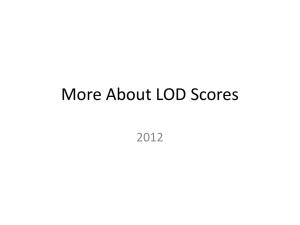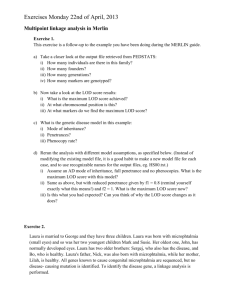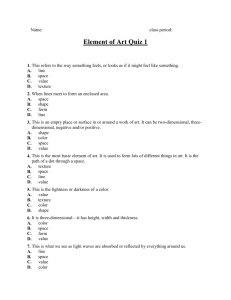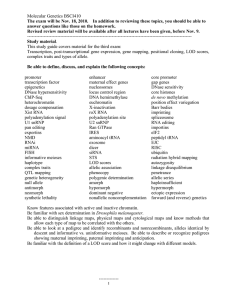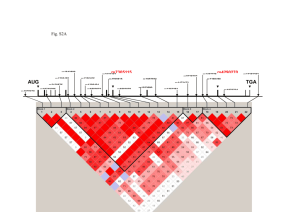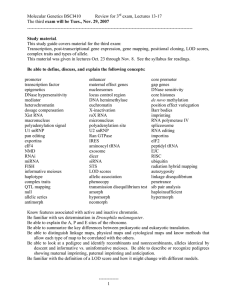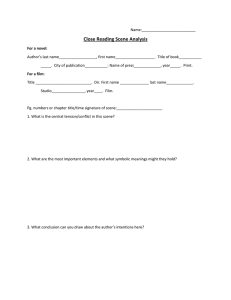STUDY ON WEB-BASED DISTRIBUTED VIRTUAL CITY ENVIRONMENT a,
advertisement
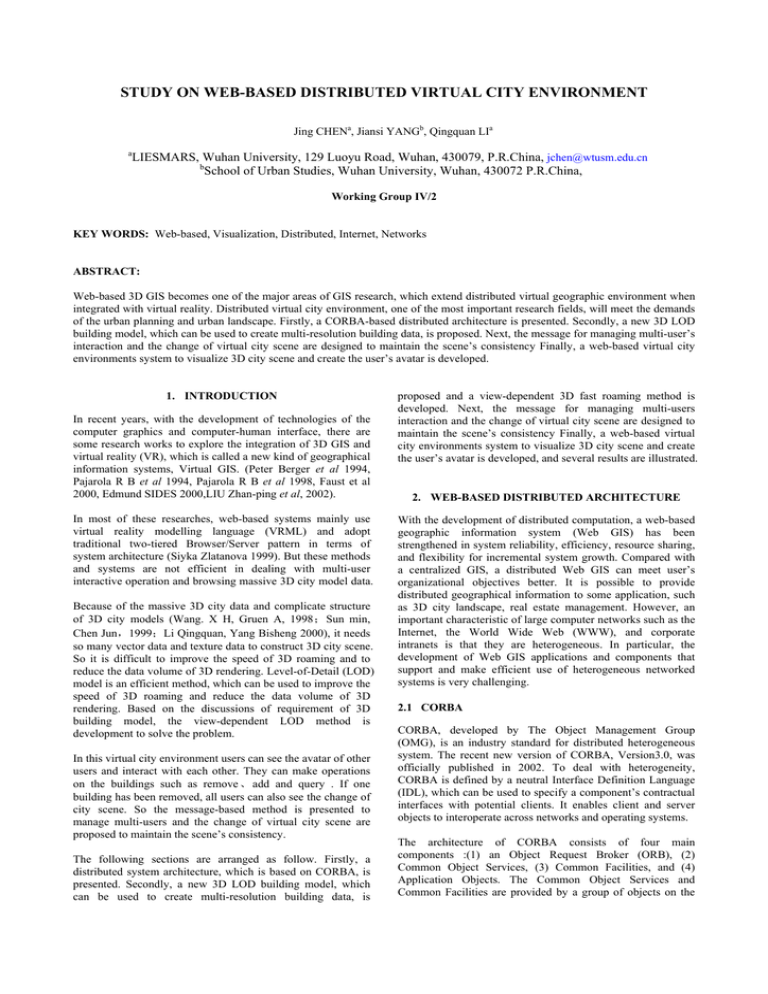
STUDY ON WEB-BASED DISTRIBUTED VIRTUAL CITY ENVIRONMENT Jing CHENa, Jiansi YANGb, Qingquan LIa a LIESMARS, Wuhan University, 129 Luoyu Road, Wuhan, 430079, P.R.China, jchen@wtusm.edu.cn b School of Urban Studies, Wuhan University, Wuhan, 430072 P.R.China, Working Group IV/2 KEY WORDS: Web-based, Visualization, Distributed, Internet, Networks ABSTRACT: Web-based 3D GIS becomes one of the major areas of GIS research, which extend distributed virtual geographic environment when integrated with virtual reality. Distributed virtual city environment, one of the most important research fields, will meet the demands of the urban planning and urban landscape. Firstly, a CORBA-based distributed architecture is presented. Secondly, a new 3D LOD building model, which can be used to create multi-resolution building data, is proposed. Next, the message for managing multi-user’s interaction and the change of virtual city scene are designed to maintain the scene’s consistency Finally, a web-based virtual city environments system to visualize 3D city scene and create the user’s avatar is developed. 1. INTRODUCTION In recent years, with the development of technologies of the computer graphics and computer-human interface, there are some research works to explore the integration of 3D GIS and virtual reality (VR), which is called a new kind of geographical information systems, Virtual GIS. (Peter Berger et al 1994, Pajarola R B et al 1994, Pajarola R B et al 1998, Faust et al 2000, Edmund SIDES 2000,LIU Zhan-ping et al, 2002). In most of these researches, web-based systems mainly use virtual reality modelling language (VRML) and adopt traditional two-tiered Browser/Server pattern in terms of system architecture (Siyka Zlatanova 1999). But these methods and systems are not efficient in dealing with multi-user interactive operation and browsing massive 3D city model data. Because of the massive 3D city data and complicate structure of 3D city models (Wang. X H, Gruen A, 1998;Sun min, Chen Jun,1999;Li Qingquan, Yang Bisheng 2000), it needs so many vector data and texture data to construct 3D city scene. So it is difficult to improve the speed of 3D roaming and to reduce the data volume of 3D rendering. Level-of-Detail (LOD) model is an efficient method, which can be used to improve the speed of 3D roaming and reduce the data volume of 3D rendering. Based on the discussions of requirement of 3D building model, the view-dependent LOD method is development to solve the problem. In this virtual city environment users can see the avatar of other users and interact with each other. They can make operations on the buildings such as remove 、 add and query . If one building has been removed, all users can also see the change of city scene. So the message-based method is presented to manage multi-users and the change of virtual city scene are proposed to maintain the scene’s consistency. The following sections are arranged as follow. Firstly, a distributed system architecture, which is based on CORBA, is presented. Secondly, a new 3D LOD building model, which can be used to create multi-resolution building data, is proposed and a view-dependent 3D fast roaming method is developed. Next, the message for managing multi-users interaction and the change of virtual city scene are designed to maintain the scene’s consistency Finally, a web-based virtual city environments system to visualize 3D city scene and create the user’s avatar is developed, and several results are illustrated. 2. WEB-BASED DISTRIBUTED ARCHITECTURE With the development of distributed computation, a web-based geographic information system (Web GIS) has been strengthened in system reliability, efficiency, resource sharing, and flexibility for incremental system growth. Compared with a centralized GIS, a distributed Web GIS can meet user’s organizational objectives better. It is possible to provide distributed geographical information to some application, such as 3D city landscape, real estate management. However, an important characteristic of large computer networks such as the Internet, the World Wide Web (WWW), and corporate intranets is that they are heterogeneous. In particular, the development of Web GIS applications and components that support and make efficient use of heterogeneous networked systems is very challenging. 2.1 CORBA CORBA, developed by The Object Management Group (OMG), is an industry standard for distributed heterogeneous system. The recent new version of CORBA, Version3.0, was officially published in 2002. To deal with heterogeneity, CORBA is defined by a neutral Interface Definition Language (IDL), which can be used to specify a component’s contractual interfaces with potential clients. It enables client and server objects to interoperate across networks and operating systems. The architecture of CORBA consists of four main components :(1) an Object Request Broker (ORB), (2) Common Object Services, (3) Common Facilities, and (4) Application Objects. The Common Object Services and Common Facilities are provided by a group of objects on the The International Archives of the Photogrammetry, Remote Sensing and Spatial Information Sciences, Vol. 34, Part XXX ORB. An ORB is the software bus that connects all the objects in the system. It enables objects to transparently make requests to-and to receive responses from-other objects located locally or remotely. The client is not aware of the mechanisms used to communicate with, active, or store the server object. The following figure illustrates the primary components in the CORBA ORB architecture. a) It consists of four components: browser side, Web server, application server and the data server, which can improve the system’s efficiency and stability. b) The 3D city applet is downloaded from web server and can communicate with CORBA server by ORB gateway. Using this method, the limited that applet only communication with the Web server will be resolved. c) The CORBA server can allocate the computer tasks to different computer servers in order to deal with load balancing problems. The key module of the system is the application server. According to the bounding of the request city data, the requested city data will be obtained from spatial database. Also according the distance of viewpoint and the angle of view, this application server will decide to use one of the LOD building model and image resolutions. Figure 1. CORBA ORB Architecture 2.2 CORBA-based Distributed Architecture In this paper, the system architecture is designed on the basis of the three-tiered Browser/Server pattern (See Figure 2). Compared with the other distributed architectures of Web GIS, such as J2EE 、 DCOM, This architecture has several advantages: Web Server Java Applet (3D City Scene) HTTP Server ORB LIB CORBA ORB LIB Connection Pool Server ORB (Internet /Intranet) Browser In order to handle multi-users operation and network analysis, a connection pool is designed using multi-threads technology. The connection pool has some active connection threads. The number of the active connection threads can be configured. If a request is coming and the connection pool also has an active connection thread, the request will be allocated an active connection thread to respond the operation. Otherwise, the request will activate a new connection thread to hand the operation. If the operation finished, the connection thread related to him will be a free connection thread. There is also a database buffer to improve the speed of the data request from spatial database. Image Server Image DB ORB LIB CORBA Services City Server City DB ORB LIB Figure.2 Distributed Web Architecture Based on CORBA 3. LOD BUILDING MODEL In recent years, the development in 3D city model is very rapid, especially in the fields of 3D data model and 3D data structure. There are so many 3D city models, which can be used to reconstruction the 3D city landscape. (Wang. X H, Gruen A, 1998;Sun min, Chen Jun, 1999;Li Qingquan,Yang Bisheng 2000).But the data model and data structure of these 3D city models are complex, it will use many image data as building’s texture. If using there 3D city models to visualization of Web-based 3D city environments, it will take so long time to download the 3D city data from server side and construct the 3D city landscape at browser side. In the 3D city model, the mainly model is 3D building model, therefore, the 3D building model must be developed which is suited to implement web-based 3D city visualization. It well known that the LOD technique is useful to improve the speed of operating large 3D city data set. Therefore, the data structure of LOD building model is presented as follow (see figure 3): In this LOD building model, the buildings can be decomposed into five basic shapes: the roof, the bottom of buildings, the The International Archives of the Photogrammetry, Remote Sensing and Spatial Information Sciences, Vol. 34, Part XXX inner body, the outer body and the virtual box. The outer shape of building will be composed of some LOD shapes. Because almost all the surfaces of outer shape of buildings are rectangles, these LOS shapes can be constructed by indexed quadrangles (index, x1, y1, x2, y2,…xn, yn, z 1 , z 2 ), where z 1 is the height of bottom of surface and z 2 is the height of top surface. There are also diverse resolution textures which relative to diverse LOD shapes. According to the distance from viewpoint to the position of building, the outer shape of building can be used diverse LOD shape. Building ID Outer Body LOD Shape1 IndexQuadArray Inner Body LOD Shape2 VRML 3DS LOD Texture Bottom DEM (GRID) Surface Virtual Box Roof Bounding Box IndexQuadArray DEM (TIN) Surface IndexTrangleArray Figure 3: Data Structure of LOD Building Model Because of the complexity shape of building roof, the roof can be depicted with DEM (TIN) surface, which is composed of indexed triangles array. The bottom of building must be suited the city terrain. Generally, the city terrain is constructed by DEM (GRID model). The inner shape of building will be reconstruct with VRML or 3DS file, this file can be linked in web page. The building has a virtual bounding box, which is approximate shape of building. While the building is so far from the viewer, the building will be depicted as his virtual bounding box. 4.1 Multi-resolution LOD texture Image data is used to map texture on the surface of 3D building model, which is very important in 3D city model. It can enhance the reality of 3D city scene. According the user’s observation habit, the building texture mapping is the farther part of 3D building model to the viewer needs lower resolution image on its surface, the nearer part of 3D building model to the viewer needs higher resolution image. See the figure 4, Therefore, the multi-resolution LOD texture data structure is proposed. The table 1 shows the structure of multi-resolution LOD texture data. Compared to other 3D city model, LOD building model has several advantages for reconstructing web-based 3D city landscape. a) The vector data to be used to construct the building will be indexed triangles array or indexed quadrangles array. This will use fewer vector data to construct buildings at the same amount of buildings. b) The outer shape of buildings has some LOD of shapes. It will improve the speed of visualization of lager 3D city scene. c) The outer shape has multiple images, which are used as building texture. The multiple images have diverse resolution. 4. THE NETWORK LOD METHOD The network LOD method includes: (1) the multi-resolution LOD texture. (2) visibility-based dynamic city scene visualization. Figure 4. Multi- resolution LOD texture In this multi-resolution LOD texture structure, the every surface texture of building is created some resolution layer. Every layer is created by the different resolution image data and compressed by JPEG format. By this way, the texture data volume will be reduce and transmitted faster via network. The International Archives of the Photogrammetry, Remote Sensing and Spatial Information Sciences, Vol. 34, Part XXX Texture LOD layer Texture ID Texture Size Texture Data 0 1096 64X64 JPEG2000Byte [] 1 1096 32X32 JPEG2000Byte [] 2 1096 16X16 JPEG2000Byte [] 3 1096 8X8 JPEG2000Byte [] Surface texture 1 … Surface texture2 … … … … 0 1262 128X64 JPEG2000Byte [] 1 1262 64X32 JPEG2000Byte [] 2 1262 32X16 JPEG2000Byte [] 3 1262 16X8 JPEG2000Byte [] Table1. The structure of multi-resolution LOD texture 4.2 Visibility-based city scene visualization When the user begins to roam the city scene, a set of parameters such as the height of viewpoint, angle of view (AOV), pitch and yaw are computed. The data cache of nine multi- resolution city blocks is obtained from server side. In the area of data cache, there is the original viewpoint (point A) and the end of viewpoint (point B) (see figure 5). While the viewpoint is moving from point A to point B, only several data blocks need obtained from city model data at server side, and it has enough time to transfer the data block. At same time dynamic city scene is created according to the parameters of viewpoint. 1. B Range the range of message MsgContent the content of message 6. EXPERIMENTS With these methods a Web-based distributed virtual city system together with the aspects of visualization interface is implemented to 3D city visualize. Especially, the user can see his avatar and other user’s avatars in the city environments. Moreover, in this system, the system application server is deployed Unix platform and the other application server is deployed at Windows platform. Similar to real world, the user is able to change the visualization process according to his/her viewing habits, it provide a interactive process during flying through, which allows user to input information during procedure of visualization to construct a free envision space to fly in it. Several experimental results are shown as following in figure.6, figure 7, figure 8. Point A Figure 5. LOD Blocks for Flying Operation 5. NETWORK MESSAGES DESIGN The message is proved useful to implement the requirements of multi-user’s interaction in the virtual city environments. So, the message is designed to achieve multi-users communicate each other and to assure the consistency of multi-user’s operation and virtual scene. The message format is defined as follow: <FromID , ToID , msgType , Range , RequestReply , msgContent> From the ID of user who sends message to others To the ID of user who receives the message from message server MsgType message type RequestReply request reply Figure.6 the user avatar in the distributed virtual city scene The International Archives of the Photogrammetry, Remote Sensing and Spatial Information Sciences, Vol. 34, Part XXX Bisheng Yang, Qingquan Li, Deren Li, 1999. Building Modelling for 3D City Model. Geo-spatial In-formation Science, Vol.2.No.1, pp.109-114. MICHAEL GRBER, Graz, 1999. Managing Large 3D Urban Database. In: 47th Photogrammetry Week, Stuttgart, pp, 341349. Zlatanova, S. and Gruber, M, 1998, 3D GIS on the Web, In: Proceedings of ISPRS, Commission IV, Stuttgart, Germany, 691-699 Zlatanova, S., 3D GIS for urban development, Ph.Dissertation, ITC, 2000 David Koller, Peter Lindstrom, William Ribarsky, et al. Virtual GIS: A Real-Time 3D Geographic Information System. In Proceedings of Visualization'95. GVU Technical Report 95-14. ftp://ftp.cc.gatech.edu/pub/gvu/tr/1995/95-14.pdf Figure.7 distributed virtual city scene Peter Lindstrom, David Koller, William Ribarsky, et al An Integrated Global GIS and Visual Simulation System. ftp://ftp.gvu.gatech.edu/pub/gvu/tr/1997/97-07.pdf Dave Snowdon, Chris Greenhalgh, Steve Benford, et al. 1996,A review of distributed architecture for networked virtual reality. Virtual Reality, 2(1): 155-175 MacEachren, A.M., Edsall R., Daniel Haug D., Baxter R., Otto G., Masters R., Fuhrmann, S. and Qian L., 1999, "Virtual Environments for Geographic Visualization: Potential and Challenges", Proceedings of the 1999 workshop on new paradigms in information visualization and manipulation in conjunction with the eighth ACM international conference on Information and knowledge management, Kansas City, Missouri, United States. Rick Germas, Gert Van Maren, Edward Verbree, Frederik W Jansen. 1999, a multi-view VR interface for 3D GIS. Computer & Graphics 23, 497-506 Figure.8 querying the building attributed 7. CONCLUSIONS This paper discusses the key technologies that achieve the Web-based distributed virtual city environment. The availability of establishing web-based distributed system, which is based on CORBA and heterogeneous network, is testifies. The LOD building model for 3D city visualization is implemented for the requirements of improving the speed of roaming the city scene. The emphasis of study in the future are multi-user management and multi-user’s cooperation in the distributed virtual city environment, etc. J.Siegel. CORBA Fundamentals and Programming, New York: John Wiley & Sons, Inc., 1996 3D-GIS Moore K, Dykes J, Wood J, Using Java to interact with georeferenced VRML with a virtual field course. Computers and Geosciences, 1999, 25:1125-1136 ACKNOWLEDGEMENTS The work described in this paper was substantially supported by a Foundation for the Author of National Excellent Doctoral Dissertation of PR China no. 200244 REFERENCES Alexander Koninger, 1998. GeoInformations, 2:1,pp, 79-103. Kahkonen J, Lehto L, Kilpeinen T, et al.1999, Interactive visualization of geographical objects on the Internet. International Journal of Geographical Information Sciences, Vol (13): 429-438 for purposes. Armin Gruen, Xinhua Wang, 1998. CC-Modeler: a topology generator for 3-D City models. ISPRS Journal of Photogrammetry&Remote Sensing 53,pp. 286-295.
